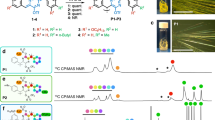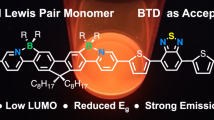Abstract
Although ladder polymers have been known for some time, poor solubility and low molecular weights have prevented processing and have discouraged consideration of these materials for structural and electronic applications. Poor solubility can be associated with strong Van der Waals interactions between delocalized π-electron clouds on adjacent chains. The optimum orbital overlap along the polymer backbone existent for ladder polymers has motivated reexamination of these systems for electronic applications. We have pursued alternatives to the tradiational acid-catalyzed polycondensation of underivatized monomers at elevated temperatures by reacting derivatized (e.g., with alkyl or vinylamine substituents) monomers at reduced temperature in organic solvents (e.g., DMF) to produce open-chain precursors to ladder polymers. These are converted to fully-fused ladder polymers by thermal processing either in solution or as solid state (e.g., thin film) materials. The preparation of precursors of improved solubility greatly enhances processing options and has permitted the utilization of both Langmuir-Blodgett methods and the perparation of optical quality films by casting (including spin casting). By control of thermal processing conditions, both derivatized and underivatized ladder polymers have been prepared. Our approach offers obvious advantages for the investigation of the effect of conformation and of substituents upon electronic properties. The preparation of copolymers with rigid rod and flexible chain segments incorporated in the polymer backbone has also been investigated. For such materials, polymers with fully fused ladder segments can exhibit improved solubility in DMF relative to polymers with open chain segments due to the absence of favorable hydrogen bonding stuctures in the former. Finally, we are investigating the effect of electrochemical polymerization of Langmuir-Blodgett films prepared with derivatized diaminobenzene. Such an approach clearly takes advantage of improved solubility of the derivatized monomer and improved molecular order which can be realized with the Langmuir-Blodgett method. Free radical polymerization may facilitate the realization of improved molecular weight distributions.
Similar content being viewed by others
References
D. J. Williams, Nonlinear Optical Properties of Organic and Polymeric Materials (American Chemical Society, Washington, D.C., 1983).
Y. R. Shen, The Principles of Nonlinear Optics, (Academic Press, New York, 1984).
C. Flytzanis and J. L. Oudar, Nonlinear Optics: Materials and Devices, (Springer, New York, 1986).
Molecular and Polymeric Optoelectronic Materials: Fundamentals and Applications, (SPIE Proceedings, 682, 1986).
Advances in Nonlinear Polymers and Inorganic Crystals, Liquid Crystals and Laser Media, (SPIE Proceedings, 824, 1987).
D. H. Auston, et. al., “Research on Nonlinear Optics: An Assessment,” Appl. Optics 26, 211 (1987).
D. S. Chemla and J. Zyss, Nonlinear Optical Properties of Organic Molecules and Crystals, Vols. 1 and 2 (Academic Press, New York, 1987).
P. N. Prasad and D. R. Ulrich, Nonlinear Optical and Electroactive Polymers, (Plenum Press, New York, 1988).
A. J. Heeger, J. Orenstein, and D. R. Ulrich, Nonlinear Optical Properties of Polymers, (Material Research Society, Pittsburgh, 1988).
J. Messier, F. Kajzar, P. N. Prasad, and D. R. Ulrich, Nonlinear Optical Effects in Organic Polymers, (NATO ASI Series No. 971, 1988).
J. K. Stille and E. Mainen, Polym. Lett. 4, 39 (1966).
J. K. Stille and E. Mainen, Macromolecules 1, 36 (1968).
J. K. Stille and M. E. Freeburger, Polym. Sci. A-1, 6, 161 (1968).
R. L. Van Deusen, Polym. Lett. 4, 211 (1966).
F. E. Arnold and R. L. VanDeusen, Macromolecules 2, 497 (1969).
F. E. Arnold and R. L. VanDeusen, J. Appl. Polym. Sci. 15, 1035 (1971).
T. Skotheim, Electroresponsive Molecular and Polymeric Systems, (Marcel Dekker,New York, 1989).
A. O. Patil, Y. Shenoue, F. Wudl, and A. J. Heeger, J. Amer. Chem. Soc. 109, 1858 (1987).
R. L. Elsenbaumer, K. Y. Jen, G. G. Miller, and L. W. Shacklette, Syn. Met. 18, 277 (1987).
M. Sato, S. Tanaka, and K. Kaeriyama, Syn. Met. 18, 229 (1987).
D. R. Gagnoon, J. D. Capistran, F. E. Karasz, R. W. Lenz, S. Antoun: Polymer 28, 567 (1987).
D. Buckley, J. B. Henbest, and P. J. Slade, J. Chem. Soc. 4891 (1987).
R. Nietzki and A. Schedler, Ber. 30, 1666 (1987).
H. A. Vogel and C. S. Marvel, J. Polym. Sci. 50, 511 (1961).
Author information
Authors and Affiliations
Rights and permissions
About this article
Cite this article
Dalton, L.R., Yu, L. Synthesis of Ladder Polymers Via Soluble Precursor Polymers. MRS Online Proceedings Library 134, 107–115 (1988). https://doi.org/10.1557/PROC-134-107
Published:
Issue Date:
DOI: https://doi.org/10.1557/PROC-134-107




